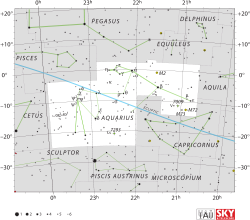Mu Aquarii
| Observation data Epoch J2000 Equinox J2000 | |
|---|---|
| Constellation | Aquarius |
| Right ascension | 20h 52m 39.23277s[1] |
| Declination | −08° 58′ 59.9499″[1] |
| Apparent magnitude (V) | 4.731[2] |
| Characteristics | |
| Spectral type | A3m[3] |
| U−B color index | +0.149[2] |
| B−V color index | +0.322[2] |
| Astrometry | |
| Radial velocity (Rv) | −9.1[4] km/s |
| Proper motion (μ) | RA: +45.75[1] mas/yr Dec.: -33.59[1] mas/yr |
| Parallax (π) | 20.74 ± 0.29 mas[1] |
| Distance | 157 ± 2 ly (48.2 ± 0.7 pc) |
| Absolute magnitude (MV) | +1.31[5] |
| Details | |
| Luminosity | 24.6[6] L☉ |
| Surface gravity (log g) | 3.99[6] cgs |
| Temperature | 7,181[6] K |
| Rotational velocity (v sin i) | 53.7[6] km/s |
| Other designations | |
| Database references | |
| SIMBAD | data |
Mu Aquarii, Latinized from μ Aquarii, is the Bayer designation for a binary star[8] system in the equatorial constellation of Aquarius. It is visible to the naked eye with a combined apparent visual magnitude of 4.7.[2] Based upon parallax measurements, the distance to this system is about 157 light-years (48 parsecs).[1] Mu Aquarii is a spectroscopic binary with an orbital period of 1,566 days and an eccentricity of 0.23.[9] The combined spectrum matches a stellar classification of A3m, with the 'm' suffix indicating that this is an Am, or chemically peculiar star.[3]
This star together with ν Aquarii is Albulaan, derived from an Arabic term al-bulacān (ألبولعان) meaning "the two swallowers". This star, along with ε Aqr (Albali) and ν Aqr (Albulaan), were al Bulaʽ (البلع), the Swallower.[10][11] In Chinese, 女宿 (Nǚ Xiù), meaning Girl (asterism) (or Woman), refers to an asterism consisting of μ Aquarii, ε Aquarii, 4 Aquarii, 5 Aquarii and 3 Aquarii.[12] Consequently, μ Aquarii itself is known as 女宿二 (Nǚ Xiù èr, Template:Lang-en.)[13]
References
- ^ a b c d e f van Leeuwen, F. (November 2007), "Validation of the new Hipparcos reduction", Astronomy and Astrophysics, 474 (2): 653–664, arXiv:0708.1752, Bibcode:2007A&A...474..653V, doi:10.1051/0004-6361:20078357.
- ^ a b c d Gutierrez-Moreno, Adelina; et al. (1966), A System of photometric standards, vol. 1, Publicaciones Universidad de Chile, Department de Astronomy, pp. 1–17, Bibcode:1966PDAUC...1....1G.
- ^ a b Cowley, A.; et al. (April 1969), "A study of the bright A stars. I. A catalogue of spectral classifications", Astronomical Journal, 74: 375–406, Bibcode:1969AJ.....74..375C, doi:10.1086/110819.
- ^ Wilson, Ralph Elmer (1953). General Catalogue of Stellar Radial Velocities. Washington: Carnegie Institution of Washington. Bibcode:1953GCRV..C......0W.
{{cite book}}: CS1 maint: postscript (link) - ^ Anderson, E.; Francis, Ch. (2012), "XHIP: An extended hipparcos compilation", Astronomy Letters, 38 (5): 331, arXiv:1108.4971, Bibcode:2012AstL...38..331A, doi:10.1134/S1063773712050015.
- ^ a b c d Schröder, C.; Reiners, A.; Schmitt, J. H. M. M. (January 2009). "Ca II HK emission in rapidly rotating stars. Evidence for an onset of the solar-type dynamo". Astronomy and Astrophysics. 493 (3): 1099–1107. Bibcode:2009A&A...493.1099S. doi:10.1051/0004-6361:200810377.
{{cite journal}}: CS1 maint: postscript (link) - ^ "* 6 Aqr". SIMBAD. Centre de données astronomiques de Strasbourg. Retrieved 2012-07-01.
{{cite web}}: CS1 maint: postscript (link) - ^ Eggleton, P. P.; Tokovinin, A. A. (September 2008), "A catalogue of multiplicity among bright stellar systems", Monthly Notices of the Royal Astronomical Society, 389 (2): 869–879, arXiv:0806.2878, Bibcode:2008MNRAS.389..869E, doi:10.1111/j.1365-2966.2008.13596.x.
{{citation}}: CS1 maint: unflagged free DOI (link) - ^ Abt, Helmut A. (August 2005), "Observed Orbital Eccentricities", The Astrophysical Journal, 629 (1): 507–511, Bibcode:2005ApJ...629..507A, doi:10.1086/431207.
- ^ Davis Jr., G. A. (October 1944), "The Pronunciations, Derivations, and Meanings of a Selected List of Star Names", Popular Astronomy, 52 (3): 12, Bibcode:1944PA.....52....8D.
- ^ Allen, R. H. (1963), Star Names: Their Lore and Meaning (Reprint ed.), New York: Dover Publications Inc, p. 53, ISBN 0-486-21079-0, retrieved 2010-12-12.
- ^ Template:Zh icon 中國星座神話, written by 陳久金. Published by 台灣書房出版有限公司, 2005, ISBN 978-986-7332-25-7.
- ^ Template:Zh icon AEEA (Activities of Exhibition and Education in Astronomy) 天文教育資訊網 2006 年 5 月 14 日

